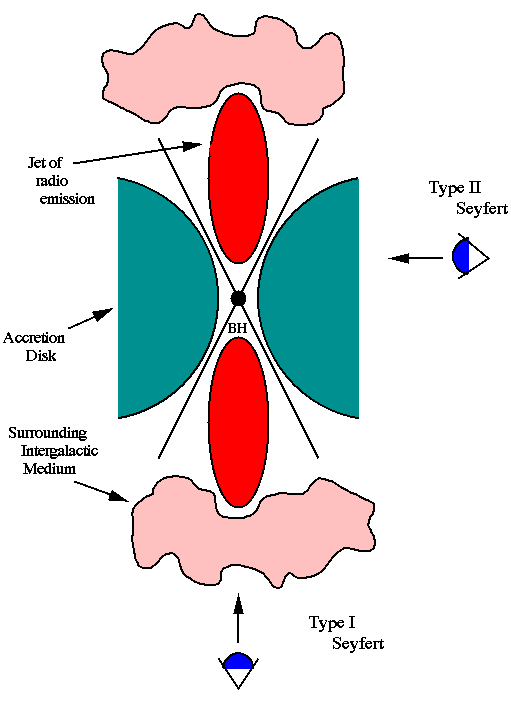Seyfert galaxies are spiral or irregular galaxies containing an extremely bright nucleus that can sometimes outshine the surrounding galaxy. The light from the central nucleus varies in less than a year, which implies that the emitting region must be less than one light year across. They are named for the astronomer Carl Seyfert, who studied them extensively in the 1940s. Approximately 2% of all spiral galaxies are Seyfert galaxies.
The spectra of Seyfert galaxies are characterized by very bright emission lines of hydrogen, helium, nitrogen, and oxygen. These emission lines exhibit strong Doppler broadening, which implies velocities from 500 to 4000 km/s, and are believed to originate in an accretion disk surrounding the central black hole. Seyfert galaxies also show strong emission in the radio, infrared, ultraviolet, and X-rays parts of the spectrum.
Nuclear region of one of the brightest Seyfert galaxies, M77 (NGC 1068). Credit: NASA/ESA, D Macchetto (ESA/STScI), W Sparks and A Capetti (STScI)
The luminosity of Seyfert galaxies is typically 100,000,000,000 times the luminosity of the sun, making the tiny nuclear region as luminous as an entire galaxy of stars. The inferred mass of the central black hole is 10,000,000 times the mass of the sun. The luminosity is proportional to the mass-accretion rate, which is approximately the mass of the sun per year. Small values of these parameters are associated with low-luminosity Seyfert galaxies, and large values are thought to characterize the much rarer, high-luminosity quasars.
Seyfert galaxies were originally classified as Type 1 and Type 2. Both types have emission spectral lines in their nuclei, which is evidence of highly excited gas (see spectral figure below). The difference arises in the shape of the emission lines. The emission lines of Type 1 Seyferts are very broad, suggesting gas velocities of several 1000 km/sec. The emission lines of Type 2 Seyferts are much narrower, which suggests that the gas in these galaxies is moving much more slowly (several 100 km/sec). More recently, intermediate classifications of Seyfert 1.5, 1.8, and 1.9 have been proposed, where the subclasses are based purely on the appearance of the optical spectrum, with numerically larger subclasses having weaker broad-line components relative to the narrow lines. In Seyfert 1.9, the broad lines are only detectable for H alpha lines, while for 1.8, weak broad H beta lines can be detected also, and for Seyfert 1.5 nuclei, the strengths of broad and narrow H beta components are comparable.
The origin of the differences between type 1 and type 2 Seyfert galaxies is not fully established. One widely believed school of thought holds that all Seyfert 2 galaxies are intrinsically Seyfert 1 galaxies, but that we are unable to see the broad components of the lines from our particular vantage point. Specifically, we are viewing Type 1 Seyferts nearly along the jets (see figure at bottom). Here, we would expect to see broad lines because the gas is very hot and moving rapidly. Type 2 Seyferts are viewed almost directly through the accretion disk. The disk blocks the light form the central black hole and the jet. The light we see comes from slower-moving gas farther from the black hole and, thus, produces a narrower line.
Above: Spectra of normal galaxies is compared with other types, including the Seyfert 1 and 2 galaxies.
Left: Figure explaning how viewing angle may be primary determinant of whether a Seyfert galaxy is classified as type 1 or 2. BH, black hole.





